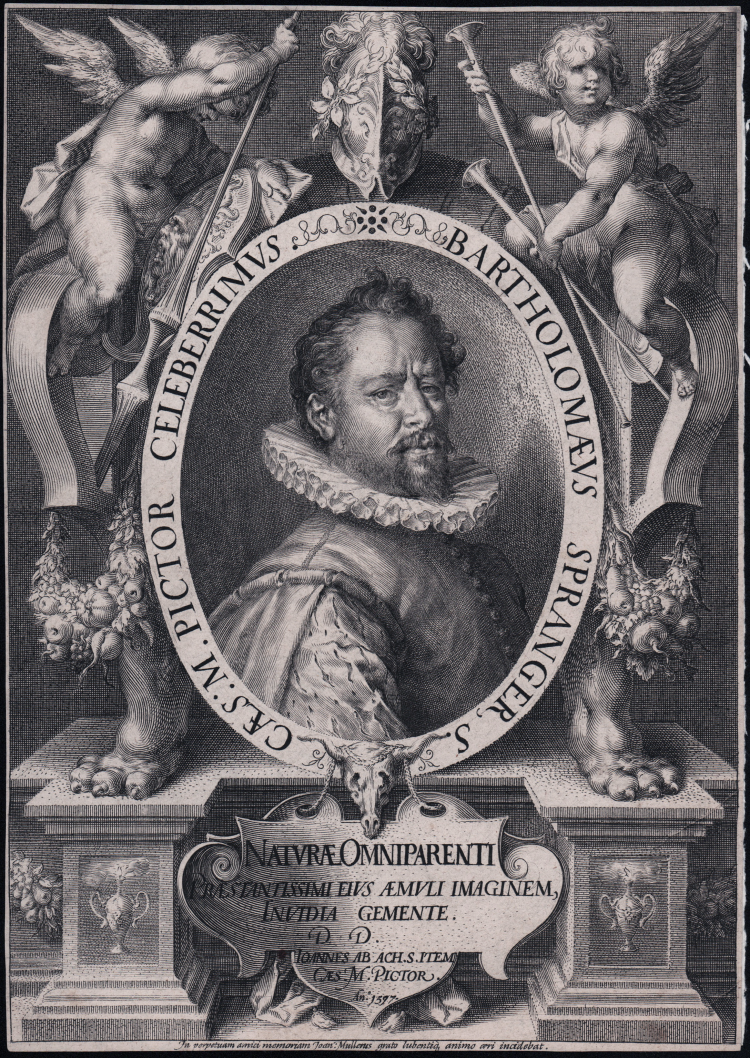




| Reference: | S39262 |
| Author | Jan Harmensz MULLER |
| Year: | 1597 |
| Measures: | 182 x 257 mm |



| Reference: | S39262 |
| Author | Jan Harmensz MULLER |
| Year: | 1597 |
| Measures: | 182 x 257 mm |
Engraving, dated on plate 1597.On the frame: ‘BARTHOLOMAEUS SPRANGER, S. CAES. M. PICTOR CELEBERRIMUS’ Inscribed on the bottom, on cartouche: ‘NATURAE OMNIPARENTI / PRAESTANTISSIMI EIUS AEMULI IMAGINEM,/INVIDIA GEMENTE/D D/IOANNES AB ACH.S.ITEM/CAES. M. PICTOR / An o 1597’ inscribed on the bottom: ‘In perpetuam amici memoriam Joan Mullerus grato lubentique animo aeri incidebat / F.de Wit excudit’.
Bust portrait of Bartholomeus Spranger (1546-1611) in oval frame, flanked by two putti with trumpets, a shield, spear and a helmet.
“The oval portrait is based on a model (probably a painting) by Hans von Aachen. Both artists explicitly dedicate the print in friendship to Spranger. During this period Jan Muller had become the chief engraver of the designs by Spranger, the famous court painter of Prague, and it was around now he produced ten engravings, most of a fairly large format, after his designs. Spranger sent his drawn designs to Amsterdam and a number of extant proof impressions reveal that these were sent to Prague for correction. Muller probably did not meet Spranger until the latter’s visit to the Netherlands in 1602. It can be assumed that Hans von Aachen (1552 – 1615), another painter at the Prague court, sent Spranger’s portrait (whether painted or drawn) for Muller to use as a model for his print; the frame, however, was designed by Muller himself. Muller’s traced design for the frame, with the initial design for the portrait engraving attached inside, has been preserved (Amsterdam, Rijkprentenkabinet), and it is possible to follow the making of the print precisely through each successive stage: first the face was engraved in the plate, then the rest of the figure, after which the frame and finally the circumscription were engraved.” F. Kok, Artists Portrayed by Their Friends: Goltzius and His Circle, in Netherlands Quarterly for the History of Art,Vol. 24, pp. 167-168.
A fine example printed on contemporary laid paper, trimmed to the platemark, in good condition.
|
Le Blanc, 69; F. Kok, Artists Portrayed by Their Friends: Goltzius and His Circle, in Netherlands Quarterly for the History of Art,Vol. 24, pp. 167-168.
|
Jan Harmensz MULLER (Amsterdam 1571 - 1628)
|
Dutch engraver, draughtsman and painter. He was the eldest son of Harmen Jansz. Muller (1540–1617), the Amsterdam book printer, engraver and publisher. The family business, called De Vergulde Passer (‘The gilded compasses’), was situated in Warmoesstraat, and Jan Muller worked there for many years. He may have been apprenticed to Hendrik Goltzius in Haarlem. Between 1594 and 1602 he is thought to have gone to Italy, where he stayed in Rome and Naples. He was related by marriage to the Dutch sculptor Adriaen de Vries, who was a pupil of Giambologna. He also maintained contacts with Bartholomeus Spranger and other artists in Prague, which under the rule of Emperor Rudolf II had become a flourishing centre of the arts. In 1602 he made an unsuccessful attempt to mediate on behalf of Rudolf II, who wanted to buy Lucas van Leyden’s Last Judgement. When Harmen Jansz. Muller died, he left the entire stock of his shop, including a number of copperplates, to his bachelor son Jan.
|
|
Le Blanc, 69; F. Kok, Artists Portrayed by Their Friends: Goltzius and His Circle, in Netherlands Quarterly for the History of Art,Vol. 24, pp. 167-168.
|
Jan Harmensz MULLER (Amsterdam 1571 - 1628)
|
Dutch engraver, draughtsman and painter. He was the eldest son of Harmen Jansz. Muller (1540–1617), the Amsterdam book printer, engraver and publisher. The family business, called De Vergulde Passer (‘The gilded compasses’), was situated in Warmoesstraat, and Jan Muller worked there for many years. He may have been apprenticed to Hendrik Goltzius in Haarlem. Between 1594 and 1602 he is thought to have gone to Italy, where he stayed in Rome and Naples. He was related by marriage to the Dutch sculptor Adriaen de Vries, who was a pupil of Giambologna. He also maintained contacts with Bartholomeus Spranger and other artists in Prague, which under the rule of Emperor Rudolf II had become a flourishing centre of the arts. In 1602 he made an unsuccessful attempt to mediate on behalf of Rudolf II, who wanted to buy Lucas van Leyden’s Last Judgement. When Harmen Jansz. Muller died, he left the entire stock of his shop, including a number of copperplates, to his bachelor son Jan.
|